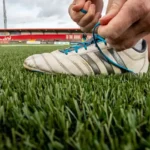Japan’s rise in global soccer isn’t a coincidence. It’s a story of grit, planning, and relentless effort. From once being considered an underdog, Japan is now producing world-class players, challenging giants, and building one of the most respected football cultures on the planet. In this article, you’ll learn exactly how Japan pulled it off — from grassroots strategies to international stardom, youth development to global exposure. Get ready to see what’s driving Japan football growth and why the world is finally paying attention.
A Humble Beginning: From Obscurity to Ambition
Before the 1990s, football in Japan was far from the spotlight. Baseball ruled the sporting scene, while soccer was seen more as a school activity than a professional pursuit. Matches barely filled stadiums, and international results were underwhelming.
Things changed in 1993 with the launch of the J.League — Japan’s professional football league. It was more than just a tournament; it marked the birth of a new vision. Backed by businesses, community support, and a strong media strategy, the J.League helped shift public perception. Suddenly, football became exciting, aspirational, and accessible.
Japan didn’t just want to participate in football. They wanted to win, and they made that clear through action. Investment flowed in, and serious efforts to scout and train talent started to take shape. The vision? Make Japan a global football force within a generation — and they were just getting started.
Building from the Roots: Youth Development That Works
One of the most important pillars in Japan football growth has been its youth development system. The Japan Football Association (JFA) didn’t try to copy European systems blindly. Instead, they focused on creating a disciplined, high-intensity training culture that aligns with the country’s core values of respect, hard work, and teamwork.
Key efforts included:
- Establishing over 12,000 certified football schools nationwide
- Creating partnerships with schools to integrate football in education
- Inviting foreign coaches with global experience to mentor local talent
- Launching age-specific training modules designed by the JFA Technical Committee
By the early 2000s, these efforts started bearing fruit. Kids weren’t just kicking balls around; they were training with purpose, learning tactical systems, and getting international exposure. Case in point: Takefusa Kubo, who joined Barcelona’s La Masia at age 10 after rising through Japan’s local circuits.
These youth programs didn’t just teach skills. They built mentality. They taught kids how to play as a unit, understand space, maintain shape, and stay calm under pressure — the kind of training you need to compete at the top.
Going Global: How Overseas Exposure Changed the Game
As Japan’s local talent pool matured, a new strategy took center stage — sending players abroad. The idea was simple but smart: to raise the game at home, Japan needed its best players to learn from the best.
Early exports like Hidetoshi Nakata and Shinji Ono set the tone. Their performances in Europe not only built credibility but also inspired a generation back home. More recently, players like Kaoru Mitoma, Daichi Kamada, and Takehiro Tomiyasu have taken top leagues by storm.
Playing in Europe has done more than sharpen individual skills. It’s influenced Japan’s playing style — making it faster, more physical, and tactically sharper. These players come back with valuable lessons, pushing domestic competition and lifting the national team’s standard.
What’s even better? J.League clubs are now using these foreign connections to build training partnerships, organize overseas tours, and scout talent smarter than ever before.
Coaching with a Mission: The Tactical Shift
One of the biggest accelerators in Japan football growth has been its approach to coaching. The Japan Football Association didn’t settle for outdated methods. Instead, they built a coaching revolution rooted in science, precision, and player psychology.
Here’s what they did differently:
- Required all J.League coaches to undergo advanced licensing and UEFA-equivalent certifications
- Introduced video analysis and data tracking as core tools for match prep
- Emphasized possession-based football with quick transitions and aggressive pressing
- Focused on developing decision-makers, not just technically gifted players
The JFA also collaborated with European football federations to exchange coaching methods, sending local coaches abroad for hands-on learning. As a result, players at every level were being trained to think faster, act smarter, and make better decisions under pressure.
The real impact? Japan’s teams now display a style that’s structured yet flexible, combining their traditional discipline with a more modern, fluid approach to the game.
Mentality First: Why Psychology Matters
Football isn’t just physical — it’s mental. Japan recognized this early and invested heavily in building a mental strength framework across all levels of the sport.
Young athletes are taught to:
- Handle failure without breaking down
- Respect referees, opponents, and teammates — always
- Stay composed under high-stakes pressure
- Focus on process over short-term results
This mindset training starts in youth academies and continues all the way to the national team. The result? A group of players who don’t panic under pressure and rarely lose control — traits that are paying off in big matches.
In the 2022 FIFA World Cup, Japan stunned the world by beating both Germany and Spain in the group stage. It wasn’t luck. It was the result of years of mental conditioning, tactical clarity, and belief in the system.
Japan isn’t just teaching kids how to play. They’re teaching them how to win — the right way.
National Team Breakthroughs: From Underdogs to Contenders
For years, Japan was seen as a team that could qualify but never contend. That perception started to shift dramatically in the last two decades.
Here’s a snapshot of their progress:
- 1998: Japan’s first FIFA World Cup appearance
- 2002: Co-hosted the World Cup with South Korea and reached the Round of 16
- 2010 & 2018: Reached Round of 16 again, showing consistency
- 2022: Topped their group by defeating Germany and Spain — both World Cup winners
What’s changed? Everything. From player quality to coaching strategy and mental strength, the team now walks into big tournaments expecting to compete, not just participate.
The Japan national team, known as the Samurai Blue, has also built strong support structures off the pitch — including nutritionists, psychologists, and elite medical teams. Their training camps are optimized, recovery protocols are strict, and players are constantly monitored for performance.
This is no longer a team hoping to win someday. This is a team designed to win now.
Case Study 1: Kaoru Mitoma – The Perfect Product of the System
Kaoru Mitoma’s journey is a powerful example of Japan’s football development success. Unlike many players who rush into pro contracts, Mitoma chose to pursue a sports science degree at the University of Tsukuba — delaying his pro debut to study football decision-making at a neurological level.
This unique academic foundation, combined with Japan’s structured youth training, helped him become one of the most intelligent wingers in the Premier League today.
He honed his skills at Kawasaki Frontale, a J.League club known for technical training, before moving to Europe and earning praise for his sharp movements, control, and football IQ. His path proves that Japan’s system isn’t just about raw talent — it’s about producing smart, adaptable players ready for the modern game.
Case Study 2: Japan vs Germany & Spain – World Cup 2022
Japan’s stunning victories over Germany (2-1) and Spain (2-1) at the 2022 World Cup were no flukes. These weren’t late-game steals or accidental wins — they were tactical masterclasses.
The team stayed compact, absorbed pressure, and struck with clinical counter-attacks. Coach Hajime Moriyasu used squad depth brilliantly, rotating players without losing structure. Substitutes made game-changing impacts — a testament to both coaching and depth of talent.
More importantly, the players believed they could win. They weren’t star-struck. They were prepared, focused, and mentally tough. It was a moment that turned global respect into genuine fear from football’s traditional powerhouses.
Pros and Cons of Japan’s Football Approach
Pros:
- Structured Youth Development: Builds discipline and strong fundamentals
- Mental Strength Programs: Keeps players composed and resilient
- Global Exposure: Players gain top-tier experience in Europe
- Tactical Coaching: Sharpens decision-making and flexibility
Cons:
- Limited Physicality: Japan still lacks raw physical strength compared to some European or African teams
- Late Bloomers: Players like Mitoma peak later due to academic paths, which can delay breakthroughs
- Scouting Gaps: Not all talents are identified early, especially in rural areas
FAQs
Who is leading Japan’s football growth today?
The Japan Football Association (JFA), along with clubs like Kawasaki Frontale and Urawa Red Diamonds, are at the forefront of development. Coaches like Hajime Moriyasu are driving the national team forward.
What makes Japan’s football strategy different?
Japan’s approach emphasizes discipline, intelligence, and mental strength over flashy individualism. They focus on building complete players who understand the game deeply.
Where does Japan rank globally in football now?
As of 2025, Japan is consistently ranked in the top 20 by FIFA and is widely seen as Asia’s top footballing nation.
Why are Japanese players thriving in Europe?
They combine high technical ability with work ethic and adaptability — traits that coaches in Europe value highly.
Will Japan ever win a World Cup?
If current growth continues, it’s not a matter of “if” but “when.” The infrastructure, mindset, and talent pool are all moving in the right direction.
Conclusion: What the World Can Learn from Japan
Japan’s rise in football isn’t about shortcuts. It’s about strategy, patience, and heart. They built from the bottom up, focused on education, embraced failure, and stayed true to their culture of humility and hard work. In doing so, they turned themselves from hopefuls into real contenders on the global stage.
Other nations chasing success can learn from Japan’s mix of planning, mindset, and community-driven development. Whether you’re a coach, a player, or a fan — Japan’s story is proof that greatness isn’t born. It’s built.
Like what you read?
Share this blog, leave a comment, and join the conversation. Let’s keep talking about how football evolves — one smart move at a time.










